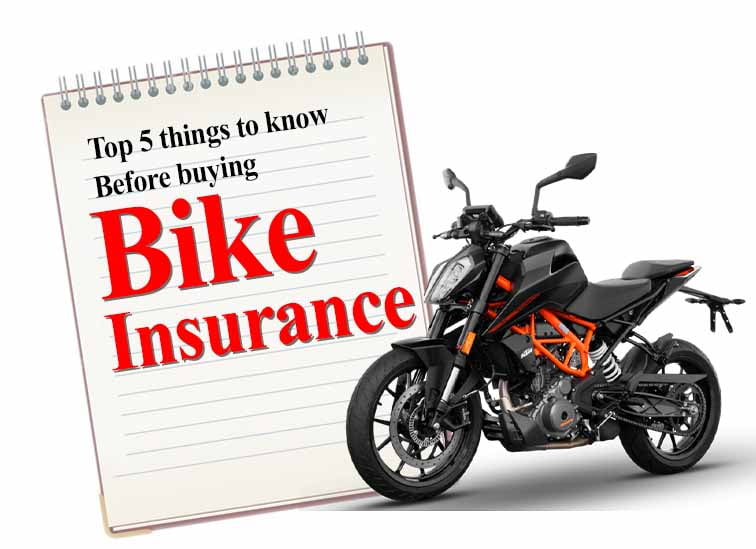Third-party cover and comprehensive cover (first-party) are the two types of bike insurance policies that Indian insurance companies offer. But whatever you choose please keep these 5 things in your mind before buying any bike insurance.
Many people have a passion for motorcycling. The rush that comes with it is unmatched. However, you need to be cautious regarding safety when riding. You must take the essential safety precautions, which include dressing safely, obeying traffic laws, and remaining vigilant. Similarly, purchasing a reliable insurance policy is a crucial step in protecting your bike against monetary damages.
According to the Indian Motor Vehicle Act, all bike owners in India are required to purchase bike insurance. It is illegal to ride without current insurance, and you risk receiving a big fine. Here are some crucial things to understand if you’re buying bike insurance for the first time in order to receive the greatest coverage.
Recent Auto News :
- Top 10 best bikes under 1 lakh in India 2024
- Honda Activa spare parts price list 2024
- TVS Jupiter 125 spare parts price list 2024
ABOUT THE COVERAGE UNDER THE BIKE INSURANCE
The two types of bike insurance policies offered by insurance firms in India are the third-party cover and comprehensive cover.
Third-party liability insurance is a requirement that must be met. It is a fundamental kind of insurance coverage that solely pays for bodily harm and property or vehicle damage to third parties. You are not entitled to financial compensation for harm done to your own bike under third-party liability.
The comprehensive cover offers total protection, as its name implies. Both damages to oneself and liabilities to third parties are covered.
Therefore, you must evaluate your needs when purchasing a new bike insurance policy and select the appropriate coverage in accordance.
It is preferable to purchase a comprehensive policy if you ride a high-end motorcycle or if you travel extensively.
However, if you only infrequently ride your bike or use it for local commuting, a third-party policy will be adequate.
EXCLUSION OF INSURANCE
The majority of consumers believe that their bike insurance will cover any losses. However, this is untrue. There are distinct exclusions for every insurance provider and every policy. You must carefully study the policy documentation before purchasing the plan to learn about the exclusions.
Exclusions are primarily the circumstances or scenarios when the insurer is not responsible for covering the costs of damage to your bike. In general, the following situations will result in your insurance company rejecting your claim:
- Accidents brought forth by electrical or mechanical failure
- The bike’s components suffered wear and tear damage.
- The loss or destruction of the vehicle as a result of terrorism or war
- Damage to the motorcycle if the rider did not have a valid license
- If the rider is found guilty of operating a vehicle while intoxicated by alcohol, drugs, or other substances, accidents may have happened.
ADD ON COVERS
In addition to the fundamental safety provided by your bike insurance, it is critical that you broaden your coverage with additional riders or covers to improve your financial security against accidents and other road catastrophes. By paying an additional fee, you can add-on covers, which are additional coverage possibilities.
To meet the various needs of the population, insurance firms provide a range of add-on coverages. Check the add-ons the insurer offers when you purchase bike insurance online. Personal accident coverage, zero depreciation coverage, and roadside assistance coverage are the three most popular types of riders that individuals purchase.
NO CLAIM BONUS
No Claim Bonus, or NCB, is an incentive given by insurance companies to cautious drivers. The award is typically provided to motivate the policyholder to drive defensively and deter them from filing numerous claims.
When your insurance is renewed, your insurer may offer you NCB if you haven’t filed any claims throughout the policy year. The NCB keeps rising yearly and can reach 50% for failure to submit a claim. Ask the insurer about NCB and its terms and conditions when you renew your policy or get two-wheeler insurance online so that you may later take benefit of it.
ACCURATE EVALUATION OF INSURANCE DECLARED VALUE (IDV)
The market worth of your motorcycle is known as the Insured Declared Value, or IDV. The insurance company will reimburse you for the IDV if your motorcycle is stolen or suffers irreparable damage. In other words, the maximum amount of compensation you can receive from the insurance company is the insured declared value.
Therefore, it is crucial that you provide the insurer the right value because it will directly affect how much you pay in premiums. The insurance provider will determine the IDV each year when the policy is renewed because the bike’s worth is always changing as a result of wear and tear.
The formula used by insurance companies to calculate IDV is as follows:
IDV = Price listed by the manufacturing company – depreciation + the additional accessories installed on your bike – depreciation “
Also see:
- How to order HSRP number plate online for your old vehicle
- 5 Tips when having a Car Towed
- How Automotive Market Insights 2021 Reshaping The Automobile Industry?
- Top 10 best bikes under 1.5 lakh in 2023
Apart from these top 5 things there are some basic things that everyone should be aware of before buying insurance.
VALIDITY OF POLICY
The term “policy validity” describes how long your insurance policy will be in effect. Keep your insurance coverage active. If your insurance is about to expire, consider renewing it a few weeks beforehand. It is against the law to drive without insurance, so make sure you renew your policy on time.
POLICY NUMBER
The insurance firm assigns a policy number to each policyholder. An individual must include the policy number while submitting a claim. The policy number is kept on file with other pertinent information, including personal and vehicle information. Verify your policy number to ensure that all of your personal information has been appropriately entered against the policy number.
INFORMATION ABOUT THE VEHICLE
It is crucial to provide the insurance company with information about your vehicle when purchasing your insurance coverage. Your policy paperwork will reflect any disclosures you make on the engine, chassis, and registration number of your vehicle. Providing correct information about your car will guarantee a simple claim procedure. Your insurance claims can be denied if there is any contradiction in this data, though.
CUSTOMER INFORMATION
Your name, age, gender, date of birth, and income will be requested, as well as other personal information, by the insurance provider. Make sure the insurer appropriately fills out your private information when it appears on the document. Get the error fixed as quickly as you can with the insurance company in the event of an inaccuracy.
Also see:
- PMV EaS-E Electric minicar launched with two seats at Rs 4.79 lakhs
- Bajaj Pulsar 125 Carbon Fibre edition launched @ Rs 89,254/-
- Top 5 Best 7 seater cars in India below 10 lakhs
Bike Insurance (two-wheeler insurance) FAQs
How to check bike insurance validity?
There are multiple ways to check the validity of your bike insurance but the famous and easiest one is using a VAHAH (Ministry of Road Transport and Highways – MoRTH) app on your smartphone. Enter the basic details on the app and it will show you all the details about your insurance, registration, PUC, etc.
What is IDV in bike insurance?
The market worth of your motorcycle is known as the Insured Declared Value, or IDV.
How to claim bike insurance?
To claim your bike insurance, you need to contact your insurance company they will guide you full procedure.
What is NCB in bike insurance?
In bike insurance, NCB stands for No Claim Bonus. It is an incentive given by insurance companies to cautious drivers. When your insurance is renewed, your insurer may offer you NCB if you haven’t filed any claims throughout the policy year.
What is third-party insurance for bike?
The third-party insurance is a fundamental kind of insurance coverage that solely pays for bodily harm and property or vehicle damage to third parties. You are not entitled to financial compensation for harm done to your own bike under third-party liability.
What is first-party insurance for bike?
The comprehensive cover (first-party insurance) offers total protection, as its name implies. Both damages to oneself and liabilities to third parties are covered.
How to find IDV of bike?
Insurance companies use this formula to calculate the IDV of bikes – “IDV = Price listed by the manufacturing company – depreciation + the additional accessories installed on your bike – depreciation”




